
FACULTY OF ENGINEERING
Department of Genetics and Bioengineering
GBE 406 | Course Introduction and Application Information
| Course Name |
Gene Control and Epigenetics
|
|
Code
|
Semester
|
Theory
(hour/week) |
Application/Lab
(hour/week) |
Local Credits
|
ECTS
|
|
GBE 406
|
Fall/Spring
|
2
|
2
|
3
|
6
|
| Prerequisites |
|
|||||||
| Course Language |
English
|
|||||||
| Course Type |
Elective
|
|||||||
| Course Level |
First Cycle
|
|||||||
| Mode of Delivery | - | |||||||
| Teaching Methods and Techniques of the Course | - | |||||||
| Course Coordinator | ||||||||
| Course Lecturer(s) | ||||||||
| Assistant(s) | - | |||||||
| Course Objectives | The aim of this course is to teach the effects of gene control and epigenetic mechanisms on pluripotency and reprogramming, their role in cell division and cell differentiation, and how errors in these mechanisms lead to diseases. It is also aimed to give techniques related to gene control and measurement of epigenetic mechanisms. |
| Learning Outcomes |
The students who succeeded in this course;
|
| Course Description | This course explains the gene control mechanisms that affect development and deteriorate in disease. The course covers epigenetic markers and related techniques to identify differences in gene regulation. |
|
|
Core Courses | |
| Major Area Courses |
X
|
|
| Supportive Courses | ||
| Media and Management Skills Courses | ||
| Transferable Skill Courses |
WEEKLY SUBJECTS AND RELATED PREPARATION STUDIES
| Week | Subjects | Related Preparation |
| 1 | Introduction | Epigenetics, Cold Spring Harbor Laboratory Press, 2015 - Chapter 1 |
| 2 | Circuit elements of a gene | Molecular Biology of the Cell 6th edition, Garland-Norton, 2015 - Chapter 1 |
| 3 | RNA polymerase and fundamentals of gene control | Molecular Biology of the Cell 6th edition, Garland-Norton, 2015. -Chapter 6. Transcription Regulation at the Core: Similarities Among Bacterial, Archaeal, and Eukaryotic RNA Polymerases, Decker and Hinton, Annual Reviews, 2013. |
| 4 | Chromatin and chromsome architecture | Molecular Biology of the Cell 6th edition, Garland-Norton, 2015. - Chapter 4. |
| 5 | Histone modifications | Epigenetics, Cold Spring Harbor Laboratory Press, 2015.- Chapters 4,5,6. Lateral Thinking: How Histone Modifications Regulate Gene Expression, Lawrence et al., Trends in Genetics, 2016. |
| 6 | Dynamics of chromatin remodeling | Mechanisms of action and regulation of ATP-dependent chromatin-remodelling complexes, Clapier et al. , Nature Reviews, 2017. |
| 7 | Chromatin balance and gene insulation | Heterochromatin effects in Friedreich's ataxia and sexual dimorphism. C. Yandım, PhD Thesis, Imperial College London, 2012. Gene Regulation and Epigenetics in Friedreich's ataxia. Yandım et al. J of Neurochem., 2013. |
| 8 | Midterm Exam | Epigenetics, Cold Spring Harbor Laboratory Press, 2015- Chapter13 |
| 9 | Nuclear architecture | Biogenesis and function of nuclear bodies, Mao et al, Trends in Genetics, 2011. |
| 10 | DNA methylation and epigenetic reprogramming | Principles of DNA methylation and their implications for biology and medicine, Dor and Cedar., Lancet, 2018. |
| 11 | RNA interference | Strategies for silencing human disease using RNA interference, Kim and Rossi, Nature Reviews, 2007. |
| 12 | Epigenetic memory | Mechanisms of epigenetic memory, D'Urso and Brickner, Trends in Genetics, 2014. |
| 13 | Induced pluripotency | Epigenetics, Cold Spring Harbor Laboratory Press, 2015. - Chapter 28 |
| 14 | Epigenetics and human disease | Epigenetics, Cold Spring Harbor Laboratory Press, 2015- Chapter 33. |
| 15 | Review | |
| 16 | Final exam |
| Course Notes/Textbooks | Epigenetics, MonikaLachlan, Spring harbor laboratory press, 2015 |
| Suggested Readings/Materials |
|
EVALUATION SYSTEM
| Semester Activities | Number | Weigthing |
| Participation | ||
| Laboratory / Application | ||
| Field Work | ||
| Quizzes / Studio Critiques |
4
|
40
|
| Portfolio | ||
| Homework / Assignments | ||
| Presentation / Jury | ||
| Project | ||
| Seminar / Workshop | ||
| Oral Exams | ||
| Midterm |
1
|
30
|
| Final Exam |
1
|
30
|
| Total |
| Weighting of Semester Activities on the Final Grade |
5
|
70
|
| Weighting of End-of-Semester Activities on the Final Grade |
1
|
30
|
| Total |
ECTS / WORKLOAD TABLE
| Semester Activities | Number | Duration (Hours) | Workload |
|---|---|---|---|
| Theoretical Course Hours (Including exam week: 16 x total hours) |
16
|
2
|
32
|
| Laboratory / Application Hours (Including exam week: '.16.' x total hours) |
16
|
2
|
32
|
| Study Hours Out of Class |
14
|
2
|
28
|
| Field Work |
0
|
||
| Quizzes / Studio Critiques |
4
|
-
|
0
|
| Portfolio |
0
|
||
| Homework / Assignments |
4
|
5
|
20
|
| Presentation / Jury |
-
|
0
|
|
| Project |
0
|
||
| Seminar / Workshop |
0
|
||
| Oral Exam |
0
|
||
| Midterms |
1
|
34
|
34
|
| Final Exam |
1
|
34
|
34
|
| Total |
180
|
COURSE LEARNING OUTCOMES AND PROGRAM QUALIFICATIONS RELATIONSHIP
|
#
|
Program Competencies/Outcomes |
* Contribution Level
|
||||
|
1
|
2
|
3
|
4
|
5
|
||
| 1 | To have adequate knowledge in Mathematics, Science and Genetics and Bioengineering; to be able to use theoretical and applied information in these areas on complex engineering problems. |
X | ||||
| 2 | To be able to identify, define, formulate, and solve complex Genetics and Bioengineering problems; to be able to select and apply proper analysis and modeling methods for this purpose. |
|||||
| 3 | To be able to design a complex system, process, device or product under realistic constraints and conditions, in such a way as to meet the requirements; to be able to apply modern design methods for this purpose. |
|||||
| 4 | To be able to devise, select, and use modern techniques and tools needed for analysis and solution of complex problems in Genetics and Bioengineering applications; to be able to use information technologies effectively. |
X | ||||
| 5 | To be able to design and conduct experiments, gather data, analyze and interpret results for investigating complex engineering problems or Genetics and Bioengineering research topics. |
X | ||||
| 6 | To be able to work efficiently in Genetics and Bioengineering disciplinary and multi-disciplinary teams; to be able to work individually. |
|||||
| 7 | To be able to communicate effectively in Turkish, both orally and in writing; to be able to author and comprehend written reports, to be able to prepare design and implementation reports, to present effectively, to be able to give and receive clear and comprehensible instructions. |
|||||
| 8 | To have knowledge about global and social impact of Genetics and Bioengineering practices on health, environment, and safety; to have knowledge about contemporary issues as they pertain to engineering; to be aware of the legal ramifications of Genetics and Bioengineering solutions. |
|||||
| 9 | To be aware of ethical behavior, professional and ethical responsibility; to have knowledge about standards utilized in Genetics and Bioengineering applications. |
|||||
| 10 | To have knowledge about industrial practices such as project management, risk management, and change management; to have awareness of entrepreneurship and innovation; to have knowledge about sustainable development. |
|||||
| 11 | To be able to collect data in the area of Genetics and Bioengineering, and to be able to communicate with colleagues in a foreign language. |
|||||
| 12 | To be able to speak a second foreign language at a medium level of fluency efficiently. |
|||||
| 13 | To recognize the need for lifelong learning; to be able to access information, to be able to stay current with developments in science and technology; to be able to relate the knowledge accumulated throughout the human history to Genetics and Bioengineering. |
|||||
*1 Lowest, 2 Low, 3 Average, 4 High, 5 Highest
NEWS |ALL NEWS
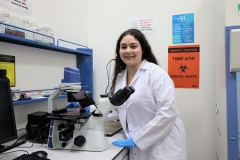
Germany chose Ezgi
Ezgi Kaya, who graduated from Izmir University of Economics (IUE) Department of Genetics and Bioengineering this year, was accepted to the world-famous
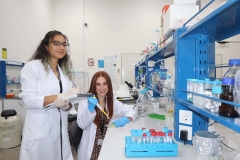
Geneticists’ success in ‘Germany’
Nine newly graduated students from Izmir University of Economics (IUE) Department of Genetics and Bioengineering achieved great success by being accepted to
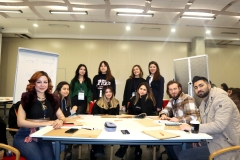
'Sustainable energy' ideas from students
Izmir University of Economics (IUE) organized a workshop on biohydrogen, which is used in many fields from industry to transportation and stands
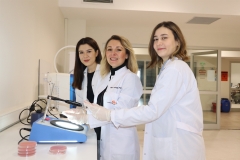
Discovery in thermal spring
Asst. Prof. Dr. Mine Güngörmüşler from Izmir University of Economics (IUE), Department of Genetics and Bioengineering, and two graduate students examined the
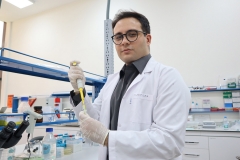
Arda ranked among 7 people in the world
Arda Kıpçak, who graduated from Department of Genetics and Bioengineering, Izmir University of Economics (IUE) this year, was accepted to the world-renowned
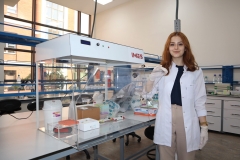
'Smart cabinet' against the virus
Assoc. Prof. Dr. Osman Doluca and his 4 students from Izmir University of Economics (IUE) developed a 'PCR cabinet' that allows samples
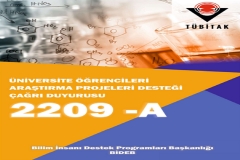
Our Senior Students are Granted Support by TÜBİTAK for Their Graduation Projects
Five of our students are entitled to receive support from TÜBİTAK (The Scientific and Technological Research Council of Turkey) within the scope
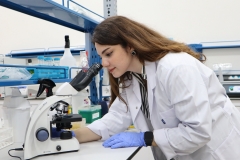
American universities welcome Aydolun with open arms
Aydolun Petenkaya, who completed Izmir University of Economics (IUE) Department of Genetics and Bioengineering as a top student with a full scholarship
